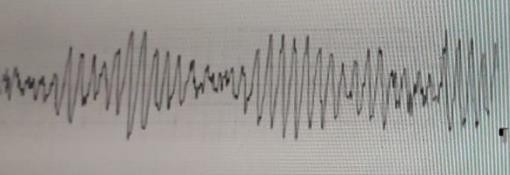Review the monitor tab and the Labs tab
Monitor

Labs
|
LAB |
Result |
Normal Range |
|
Potassium |
2.8 mEq/L |
3.5-5.3mEq/L |
|
Sodium |
133 mEq/L |
135-145 mEqL |
|
Chloride |
90 mEq/L |
97-107 mEqL |
|
Glucose |
200 mg/dL |
70mg/dL to 110mg/dL |
|
Magnesium |
2.5 mg/dL |
1.6-2.2 mg/dL |
|
Calcium |
8.0 mg/dL |
8.2-10.2 mg/dL: |
The nurse observes the rhythm below for a client on the telemetry unit. Which laboratory value result would the nurse suspect contributed to the development of this dysrhythmia?
Sodium
Magnesium
Calcium
Potassium
The Correct Answer is B
A. Sodium is crucial for maintaining normal cellular function, especially for nerve impulses and muscle contractions. However, sodium imbalances typically affect the general function of the heart, and sodium abnormalities are not commonly associated with torsades de pointes, which is a type of polymorphic ventricular tachycardia.
B. Magnesium plays a critical role in the electrical stability of the heart and helps regulate potassium and calcium channels, which are involved in the cardiac action potential. Hypomagnesemia (low magnesium) is a well-known risk factor for torsades de pointes, a specific type of polymorphic ventricular tachycardia that is associated with QT interval prolongation. In this case, the magnesium level is 2.5 mg/dL, which is above the normal range (1.6-2.2 mg/dL), suggesting hypermagnesemia.
C. Calcium is vital for proper muscle function, including the heart muscle, and is essential for electrical conduction. Hypocalcemia (low calcium) can lead to QT interval prolongation, which in turn increases the risk for arrhythmias such as torsades de pointes. However, in this case, the calcium level is 8.0 mg/dL, which is only slightly below the normal range (8.2-10.2 mg/dL), making calcium a less likely primary contributor to torsades de pointes in this situation.
D. Potassium plays a crucial role in regulating the resting membrane potential and action potentials in cardiac cells. Hypokalemia (low potassium) can lead to QT prolongation and increase the risk of arrhythmias, including torsades de pointes. However, in this case, the potassium level is 2.8 mEq/L, which is low (normal range: 3.5-5.3 mEq/L), and hypokalemia is more commonly associated with arrhythmias such as torsades de pointes than hyperkalemia (high potassium).
Nursing Test Bank
Naxlex Comprehensive Predictor Exams
Related Questions
Correct Answer is ["13.8"]
Explanation
The patient weighs 121 lbs, which is approximately 55 kg (121 ÷ 2.2).
The prescribed dose is 1 mg/kg, so the patient requires 55 mg of furosemide. The medication is supplied at a concentration of 40 mg per 10 mL.
To find out how many mL of furosemide to administer, set up a proportion: 40 mg is to 10 mL as 55 mg is to X mL.
Therefore, the nurse should administer 13.8 mL of furosemide, rounding to the nearest tenth.
Correct Answer is ["B","C","D"]
Explanation
A. Fluid intake may need to be regulated in heart failure patients, consuming 2500mL of fluids per day may be too high for some patients, depending on their condition and whether they are on fluid restriction. Fluid management should be individualized, and the provider should specify the amount based on the patient's condition.
B. A low-sodium diet is essential for heart failure patients to help reduce fluid retention, decrease blood pressure, and lessen the burden on the heart. The American Heart Association recommends a sodium intake of no more than 2,000-2,300 mg per day for heart failure patients.
C. Rapid weight gain is a sign of fluid retention, which can indicate worsening heart failure. A gain of 2-3 pounds in a single day or 5 pounds in a week should prompt the client to contact their healthcare provider for further evaluation.
D. Shortness of breath with minimal activity can be a sign of worsening heart failure or fluid overload. This symptom should be reported immediately to a healthcare provider for further evaluation and possible adjustments to treatment.
E. Furosemide (a diuretic) is often prescribed to reduce fluid retention but it should not be taken without proper guidance or as a response to symptoms without consulting the healthcare provider. Taking diuretics at the wrong time or in excessive amounts can lead to dehydration and electrolyte imbalances, which could worsen the condition.
Whether you are a student looking to ace your exams or a practicing nurse seeking to enhance your expertise , our nursing education contents will empower you with the confidence and competence to make a difference in the lives of patients and become a respected leader in the healthcare field.
Visit Naxlex, invest in your future and unlock endless possibilities with our unparalleled nursing education contents today
Report Wrong Answer on the Current Question
Do you disagree with the answer? If yes, what is your expected answer? Explain.
Kindly be descriptive with the issue you are facing.
